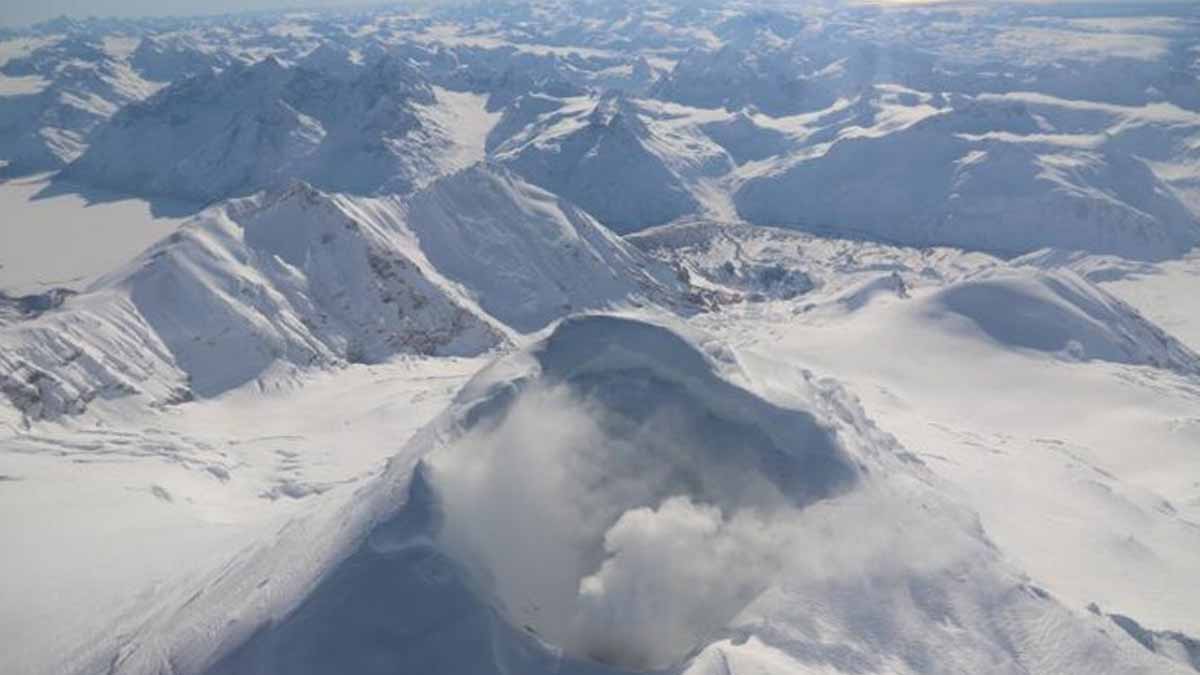A silent mountain just unlocked a noisy secret. Veniaminof, an immense Alaskan stratovolcano cloaked in ice, has revealed why some eruptions arrive with almost no hint. The puzzle matters far beyond Alaska, because volcanoes across crowded regions and busy flight routes can behave the same. New modeling and field sensors now trace the conditions that let pressure build quietly, then break fast, turning a calm skyline into ash, shock, and costly disruption.
The stealth blueprint behind Veniaminof’s strange calm
Start with scale and setting. Mount Veniaminof rises two thousand five hundred seven meters, its summit crater partly buried beneath glacier ice. That cover muffles many surface clues. Since nineteen ninety three, it has erupted thirteen times. Only two eruptions showed clear warning signals that standard networks could pick up.
In twenty twenty one, activity went unnoticed for three days despite monitoring. Aviation routes cross Alaskan skies, and ash can scour turbine blades. Remote communities also face ash fall, contaminated water, and quick evacuations. A stealth cycle therefore becomes more than a curiosity; it becomes a real public safety problem.
Researchers led by Yuyu Li at the University of Illinois built models anchored to the furtive twenty eighteen eruption. They tested how magma supply, chamber shape, and crust properties interact. Four factors emerged: slow magma ascent, a modest reservoir, thermally conditioned rocks, and geometry that minimizes quake noise during pressurization.
Why volcanoes can hide in plain sight
Why can signals stay faint even as pressure climbs? Slow magma rise reduces shaking, and a smaller chamber stores less strain. Heat from earlier intrusions softens surrounding rocks, so they flex rather than crack. Together these conditions keep surface deformation tiny, while gases vent weakly, hiding change within background noise.
Geometry matters as much as rates. A narrow conduit aligned with stress can transmit magma with minimal friction. Curved walls can cancel seismic energy the way a muffler dulls sound. Sensors then see only whispers, yet the system inches toward failure, ready to break fast once thresholds are crossed quietly.
This mechanism scales beyond one mountain. Other systems with similar shapes and histories can behave as quietly. That is why scientists warn that some volcanoes near towns or air corridors might look calm while stress accumulates. The pattern is rare, yet its consequences are large enough to demand new vigilance.
Risks, responses, and what readiness looks like
Risk lands in daily life. Ash plumes can close airports far from the source, reroute long flights, and disrupt logistics. On the ground, fine ash scratches lungs and fouls water systems. Emergency plans work best when drills consider stealth scenarios, because alarms may start late and give responders less time.
Monitoring should stack methods, not rely on one channel. Combine seismic arrays with tiltmeters for tiny tilts, and infrasound for inaudible waves. Add buried fiber optics to listen kilometers, and gas sensors for chemistry. When streams converge, weak signals can align, making the picture sharper without waiting for surface changes.
Communication must match uncertainty. Pilots need clear triggers for route changes; residents need simple, practiced actions. Labels like watch or warning should reflect probabilities, not slogans. That approach helps communities near volcanoes act early and trust guidance better, while officials refine thresholds as models learn from each event over time.
From model to warning: what volcanoes teach sensors
Since nineteen ninety three, Veniaminof has erupted thirteen times, yet only two episodes offered clear precursors. The twenty twenty one event evaded detection for three days under active monitoring. Models from the twenty eighteen eruption explain this: slow ascent and small storage damp seismic and surface deformation signals for observers.
The research team, led by Yuyu Li, used simulations to map stress paths through the crust. They found that preheated rocks act like cushions, absorbing strain without cracking. That cushioning delays obvious signals while pressure still rises, which explains how an eruption can begin before networks clearly register strong changes.
These findings, published in June twenty twenty five in Frontiers in Earth Science, mark a shift. Instead of listening for loud warnings, observatories can weight monitoring toward subtle tilts and low rumble. Targeted models flag patterns that once seemed meaningless, turning faint precursors into earlier alerts for planners and pilots.
A wider lens: global systems and echoes in time
This stealth pattern is not unique to Alaska. Popocatépetl in Mexico towers over millions; Merapi in Indonesia crowds villages; Stromboli draws tourists; Kanlaon rises above busy islands. Each site blends hazards with livelihoods, and ash clouds threaten aircraft engines. Plumes carry costs that ripple through cities, trade lanes, and services.
Clues also appear in distant records. In the Arctic, trees long frozen for six thousand years are emerging from retreating ice, revealing rhythms in landscape stress. On the Moon, canyons two miles deep reflect tectonic forces. While distinct, these patterns echo how crust stores energy, then releases it in bursts.
Detection is catching up. Machine learning now sifts seismic, infrasound, tilt, fiber, and gas data, highlighting patterns people miss. Systems learn from each eruption, reducing false alarms while raising sensitivity. As training data grows, early warning for stealthy volcanoes improves meaningfully, and communities gain more precious minutes to act decisively.
What this new clarity changes for people and planes
Veniaminof’s lesson is simple and demanding. Quiet preparation can precede fierce release, so plans must assume late signals. With smarter models, better arrays, and learning software, warnings arrive earlier, even when instruments whisper. That shift protects flights, towns, and essential networks. It also pushes scientists to revisit assumptions about volcanoes, because today’s calm can mask tomorrow’s burst, and vigilance turns uncertainty into workable safety margins. The result is not fear, but readiness shaped by evidence and tested drills.
